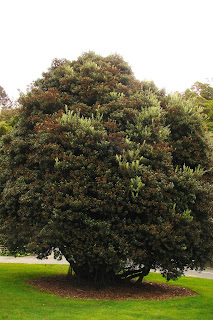Monday, 11 December 2017
Metrosideros excelsa, Pohutukawa, or New Zealand Christmas tree is endemic. It is naturally occurring from the Three Kings Islands (north of Cape Reinga) south to about Pukearuhe, northern Taranaki (in the west) and near Mahia Peninsula (in the east). However, exact southern limit is difficult to ascertain as it has been widely planted and there is evidence that old time Maori cultivated the tree in some southerly areas. Found inland around the Rotorua Lakes and at Lake Taupo - though these occurrences could stem from Maori plantings (though the association of other normally coastal species around these lakes argues against this). Now widely planted throughout the North Island and northern South Island (especially around Nelson, the Marlborough Sounds, the Kaikoura Coast and on the west coast to about Hokitika). It is found in coastal forest and on occasion inland around lake margins, also in the far north occasionally an associate of kauri forest, and in some northerly locations it forms forest type in its own right - a forest dominated by pohutukawa. A tree of up to 20m tall with a spreading canopy of (10-)20(-50)m. Specimens typically multi-trunked from base, trunks up to 2 m diam., branches spreading, and often arching, sometimes looping over ground, and/or bearing "brooms" of aerial adventitous roots. Young branchlets are hairy, covered in fine, deciduous, greyish-white hairs, and juvenile leaves will persist until the plant is 5-7 years old, are quite different from the adult leaves. Adult plants produce a variety of crimson to brilliant red flowers during December through to January. There are numerous cultivated forms that show the range of colours. Like all New Zealand trees, pohutukawa is most at risk from possum (Trichosurus vulpecula) browse. These can seriously damage and even kill trees, and often where their browsing occurs within sites of unrestricted stock and vehicle access, pohutukawa forest is in danger of becoming locally extinct. It is also at serious risk from Myrtle rust (Austropuccinia psidii) which is a serious fungal disease that affects plants in the myrtle family. Conservation of the species has been enhanced by the national coordination of Project Crimson -a non profit organisation set up to protect, enhance and/or establish pohutukawa forest, as well as promote the species use, and its conservation.
Subscribe to:
Post Comments (Atom)
Leptinella squalida subsp. mediana is endemic to the South and Stewart Islands. It is found from northwest Nelson and inland Marlborough to...

-
Olearia odorata or scented tree daisy is endemic to the South Island. Its is found in lowland and montane shrubland and scrub, in the easter...
-
Dacrydium cupressinum, rimu or red pine is endemic to the North, South and Stewart Islands - uncommon in large parts of the eastern South Is...
-
Leptinella squalida subsp. mediana is endemic to the South and Stewart Islands. It is found from northwest Nelson and inland Marlborough to...





No comments:
Post a Comment